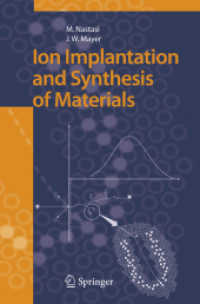- ホーム
- > 洋書
- > ドイツ書
- > Mathematics, Sciences & Technology
- > Technology
Full Description
17 2 STRESS FIELDS FOR SIMPLE STRUCTURES 2. 1 INTRODUCTION In this chapter the behavior and strength of simple structures made of rein forced or prestressed concrete is investigated with the aid of stress fields. In particular, the webs and flanges of beams, simple walls, brackets, bracing beams and joints of frames are investigated. By this means, the majority of design cases are already covered. In reality, all structural components are three-dimensional. Here, however, components are considered either directly as two-dimensional plate elements (i. e. the plane stress condition with no variation of stress over the thickness of the element) or they are subdivided into several plates. Since two-dimensional structural elements are statically redundant, it is pOSSible for a particular loading to be in equilibrium with many (theoretically an infinite number of) stress states. If the lower bound method of the theory of plasticity is employed, then an admissible stress field or any combination of such stress fields may be selected. In chapter 4 it is shown that this method is suitable for the design of reinforced concrete structures, and the consequence of the choice of the final structural system on the structural behavior is dealt with in detail. The first cases of the use of this method date back to Ritter [6] and Morsch [4], who already at the beginning of the century investigated the resultants of the internal stresses by means of truss models.
Contents
1 Introduction and Theoretical Basis.- 1.1 Introductory Remarks.- 1.2 Fundamentals of the Theory of Plasticity.- 1.3 Engineering Methods.- 2 Stress Fields for Simple Structures.- 2.1 Introduction.- 2.2 Beams with Rectangular Cross-Section Subjected to Bending and Shear.- 2.3 Beams with I-Cross-Section Subjected to Bending and Shear.- 2.4 Members Subjected to Torsion and Combined Action.- 2.5 Brackets.- 2.6 Coupling Beams.- 2.7 Joints of Frames.- 2.8 Beams with Sudden Changes in Cross-Section.- 2.9 Walls.- 2.10 Three-Dimensional Example.- 3 Material Strengths and other Properties.- 3.1 Reinforcing Steel.- 3.2 Concrete.- 3.3 Force Transfer Reinforcement — Concrete.- 4 Additional Considerations for the Development of Stress Fields.- 4.1 Remarks on Plastic Design Applied to Reinforced Concrete.- 4.2 Procedure for Developing Stress Fields.- 4.3 Impaired Strength through Wide Cracks.- 4.4 Stress Distribution in Highly Stressed Compression Zones.- 4.5 Prestressed Beams.- 5 Plane Stress, Plate and Shell Elements.- 5.1 Plane Stress Elements.- 5.2 Slab Elements.- 5.3 Shell Elements.- 6 Outlook: Computer Programs.- References.








